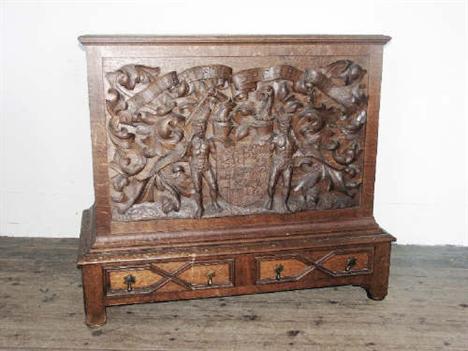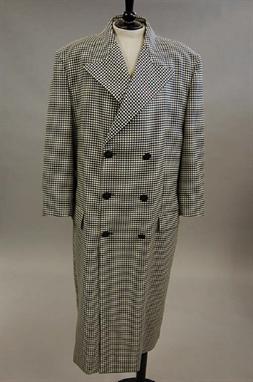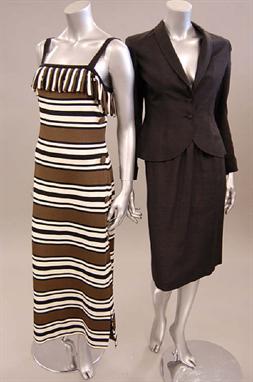We found 95795 price guide item(s) matching your search
There are 95795 lots that match your search criteria. Subscribe now to get instant access to the full price guide service.
Click here to subscribe- List
- Grid
-
95795 item(s)/page
A GEORGE II BODKIN CASE of tapering hexagonal form, the body engraved with a coat of arms, a crest and a sheath of arrows, the sides engraved with the inscription "If hands were only joined where hearts agree marriage ye happiest bond of love might be", the reverse engraved with an embracing couple and a pair of love birds, scratch initialled "I" to the lid and a galleon to the base, apparently unmarked, circa 1730, 31/2" long.
Thomas Douglas Guest (British, 1781-1845) Portrait of Tom Belcher, the Pugilist oil on canvas 75 x 70cm A mezzotint of the painting was made by C Turner, And published by Belcher himself in 1811 Literature: A Friendly Kind of Fight, 1999, illustrated on the front cover "The most scientific pugilist that ever entered A ring, only wanting strength to be, I won't say what. He Appears to walk before me now, As he did that evening, with his white hat, white great coat, thin genteel figure, springy step, And keen, determined eye" George Borrow, Lavengro Tom Belcher (1783-1854) was the younger of two Bristolian brothers who enjoyed great fame At the height of bare fist fighting's popularity. His three fights Against Sam Elias 'Dutch Sam' were Among the classics of the day, And he twice beat the Irishman Dan Dogherty, the second meeting Arranged by Lord Byron, champion of the fistic Arts. In 1814, Belcher became landlord of the Castle Tavern in Holborn, the most famous pugilistic pub of the day, And unofficial Headquarters of the ring. In 1820, he published The Art of Boxing, one of the earliest books on the sport. He was Also one of the 18 pugilists employed As 'security' At the coronation of George IV. He retired from the Castle Tavern in 1828, And Pierce Egan noted that the lucky Tom Belcher now passes his days in A very handsome cottage on Finchley Common, living At his ease like A man of fortune, with his dog And his gun, to traverse the fields when he feels inclined for A day's shooting. In 1842, After 14 years Absence from the ring, Belcher took part in A sparring match with Dick Curtis. Pugilistica wrote that the beauty of his position, And quickness And neatness of his stops And hits, reminded us of what was indeed the palmy days of the Ring. Belcher died from Apoplexy At his house in Trafalgar Square, Park Road, Peckham in December 1854. Guest entered the Royal Academy Schools in 1802 At the Age of 21, And was gold medallist in 1805. He made his name As A painter of historical And classical subjects
A Victorian silver tea caddy, Reilly and Storer, London 1851-52. of serpentine bombé form, with floral finial to the Chinoiserie decorated pull off cover, the sides similarly decorated and one with a coat of arms and motto ‘Benefictorum Memorum’ (Mindful of favours), all within a C-scroll and floral cartouche, the opposing cartouche blank, all on scroll feet, engraved to the underside ‘From Mrs. Temple to her niece Mrs. Kelham’, 13.5cm high, 14oz
A large early Victorian silver Warwick cruet, Edward I, Edward II, James and William Barnard, London 1838-39. the frame of four eagle’s masks, acanthus and claw and ball feet, with central baluster handle and reeded shell, scroll handle, the base with similar chased border, the front with a foliate scroll and diaper work cartouche, engraved with a coat of arms, fitted with three octagonal lidded casters, each on a spreading octagonal foot, the covers and with pineapple finials, two pierced, one blind, the bodies chased with panels of shells, scrolls and flowers on a matted ground; two silver-mounted cut glass bottles, with silver neck mounts chased with scrolls and foliage and each with leaf-capped scroll handles and hinged domed covers, two casters engraved with a crest, the large caster and the bottle covers engraved with a crest and motto (6), 39cm high, 110oz/r, Heraldry: The arms are those of Darby with Grant in pretence for Francis Darby Esq. of Sunniside House, Coalbrookdale, Shropshire, and his wife Hannah, only daughter of John Grant. Francis Darby was the son of Abraham Darby who, with John Wilkinson, designed and constructed the Iron Bridge over the Severn at Coalbrookdale. Provenance: Christie’s London, 15th July 1998,, lot 152 Anon sale, Christie’s New York, 5th October 1979, lot 191. The arms are those of Darby with Grant in pretence for Francis Darby Esq. of Sunniside House, Coalbrookdale, Shropshire, and his wife Hannah, only daughter of John Grant. Francis Darby was the son of Abraham Darby who, with John Wilkinson, designed and constructed the Iron Bridge over the Severn at Coalbrookdale. . Provenance: Christie's London, 15th July 1998, lot 152. Anon sale; Christie's New York, 5th October 1979, lot 191
An exceptional pair of George III Royal three light candelabra, Benjamin Smith II, London 1807-08. each on stepped circular base with gadroon detail, fanned ribbed platform with a rising socle, the stems formed as vase shaped columns with four pairs of feet and with four classical females heads with fruit head dresses, the detachable branches formed as stylised scroll dolphins, part covered in acanthus and with a clasped rosette motif, the sconces of Roman lamp form. the stems with an applied coat of arms and an engraved crest within garter (2), 59cm high, 290oz, Heraldry: The full achievement of arms plus a badge consisting of the Royal Ducal coronet surmounting the crest within the Garter for a son of George III. Provenance: Sotheby’s New York, 21st October 1998, ex collection Francis E Fowler III, lot 61. Literature: See E Alfred Jones, The Gold & Silver of Windsor Castle, pl. LXXX, for similar candelabra in the Royal Collection, The full achievement of of arms plus a badge consisting of the Royal Ducal coronet surmounting the crest within the Garter for a son of George III, . Provenance: Sotheby's New York, 21st October 1998, ex collection Francis E Fowler III, lot 61. See E Alfred Jones, The Gold & Silver of Windsor Castle pl. LXXX for similar candelabra in the Royal Collection that are illustrated and described.
A fine pair of George III silver-gilt tazze, Digby Scott and Benjamin Smith, London 1805. of circular form, the circular foot with chased band of oak leaves and acorns, the dish with a border of open work vine laves and bunches of grapes, engraved to the centre with a coat of arms and motto (2), 31.5cm diameter, 8.5cm diameter, 104oz, Heraldry: Engraved with the shield of Major-General Archibald, Lord Montgomerie, (1773-1814), and his wife (1803) Lady Mary, heiress of Archibald, 11th Earl of Eglinton and mother of Archibald, 13th Earl of Eglinton and 1st Earl of Winton, Engraved with the shield of Major-General Archibald, Lord Montgomerie, (1773-1814), and his wife (1803) Lady Mary, heiress of Archibald, 11th Earl of Eglinton and mother of Archibald, 13th Earl of Eglinton and 1st Earl of Winton
* A matched set of three George III tea caddies, one by Edward Dobson, London 1770, the pair by Robert Hennell, London 1812. each of bombe shape, the hinged covers with simple leaf clasped finial, Chinoiserie decorated detail and a coat of arms in a C-scroll cartouche, the sides with further Chinoiserie figures in terraces and landscapes, the corners with leaf clasping and all on gadroon frieze and scroll feet (3), 15cm high, 10.5cm wide, 65oz
A fine Queen Anne silver-gilt cup and cover, Pierre Platel, London 1712. of urn-form, on a circular foot with gadroon detailed border, the lower body applied with strapwork, the scroll handles with leaf grips and pendant husk decoration, the circular cover with gadrooned rim and similarly applied with strapwork surmounted by a knop finial, one side engraved with mirror cipher within baroque cartouche, the other with a later elaborate coat of arms and similar cartouche (2), 30.5cm high, 100oz/rHeraldry: The arms are those of Theophilus Fairfax Johnson, J.P. D.L. of Ayscoughfee Hall, Spalding, Lincs. and his wife nee Millicent Anne Moore. He served as High Sheriff of Lincolnshire 1847 and died 1853, The arms are quartered 1. Johnson, 2. Tyson, 3. De Vesci, 4. Fitzjohn, 5. Redhead, 6. Atkirke, 7. St Martin, 8. Downes, 9. Johnson of Pinchbeck, 10. Ogle, 11. Pinchbeck, 12. Bertram, 13. Ambler, 14. Sybsey, 15. Lessington, 16. Thorpe. The escutcheon of Moore is in pretence. Provenance: Christie’s New York, 16th April 1999, Important English Silver from a New England Collection, lot 220. S. J. Shrubsole, The arms are those of Theophilus Fairfax Johnson, J.P. D.L. of Ayscoughfee Hall, Spalding, Lincs. and his wife nee Millicent Anne Moore. He served as High Sheriff of Lincolnshire 1847 and died 1853, The arms are quartered 1. Johnson, 2. Tyson, 3. De Vesci, 4. Fitzjohn, 5. Redhead, 6. Atkirke, 7. St Martin, 8. Downes, 9. Johnson of Pinchbeck, 10. Ogle, 11. Pinchbeck, 12. Bertram, 13. Ambler, 14. Sybsey, 15. Lessington, 16. Thorpe. The escutcheon of Moore is in pretence, . Provenance: Christie's New York, 16th April 1999, Important English Silver from a New England Collection, lot 220. S. J. Shrubsole
A large white metal medallion, ‘Presented by his Excellency the Marquess of Linlithgow Viceroy of India to Duftry Govind Ram’, the obverse with a coat of arms incorporating the motto ‘At Spes Non Fracta’ and supported by maidens with anchors; together with a Queen Alexandra’s Imperial Military Nursing Service oval silver badge, Birmingham 1942. (2)
A British 1786 type Infantry Officer’s sword, spadroon blade 32 ¾ in. by Runkel of Solingen, the forte blued and with gilt highlighted engraved detail including GR asoni and the royal coat of arms, steel hilt with beaded side ring and knucklebow, steel pommel with canted edges, reeded ivory grip interrupted by a steel band, steel mounted brown leather scabbard (damaged).
A GERMAN ARMAND MARSEILLE DOLL with socket head on a composition jointed body, sleeping eyes, open mouth with teeth, marked to back of head 390n A. 4. M., dressed in an oyster coloured damask dress with diamante neck decoration, matching over coat with feather trim, socks, shoes and undergarments. 53cm tall.
Six Hausser Elastolin composition figures, including Adolf Hitler, with porcelain head, marching with cloak; Hermann Goering, with porcelain head, standing in pale blue full dress uniform, with great coat; and a Mussolini mould figure, painted with brown hair and red lips, marching with pale blue sash, each approximately 8cm high.
A group of mainly evening wear including John Bates/Jean Varon, Gina Fratini, late 60s-70s, including a Jean Varon black and white printed chiffon dress, Fratini thistle print organza; together with a quantity of cotton separates by Laura Ashley and others and a Welsh tapestry coat, various sizes, (qty)
Two Christian Dior Paris winter ensembles, late 1970s, all with black labels, comprising fitted black wool overcoat with quilted velvet facings, black trousers, green polka dot silk blouse and sash; together with a Prince of Wales checked swing coat with pleat to centre-back, matching trousers and black leather tie belt, average size chest 92cm, 36in, waist 71cm, 28in (6)
A Jacques Heim brown tweed jacket, early 1970s, with matching fox-trimmed leather cap; together with a Lanvin couture brown and white spotted suit with broad leather belt, no V85513; and a Christian Dior Paris double breasted `weather coat', average chest size 92cm, 36in, waist 71cm, 28in (qty)
Three black cocktail gowns and two coats, mid - late 1950s, comprising: black taffeta gown with cummerbund- like sash; another with black tulle overlay and lace appliqued blooms; black taffeta gown with scarlet inner skirt; a bubble-gum pink satin tent coat with broad collar, labelled Horn; and a black gros-grain wool coat, average dress size 81-86cm, 32-34in (5)
-
95795 item(s)/page























































